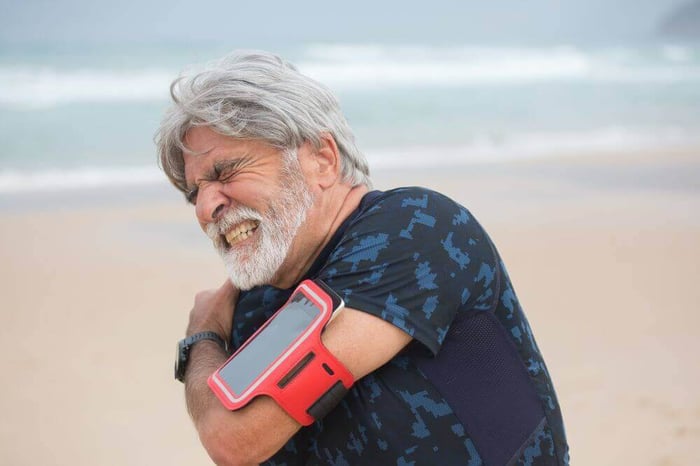Chronic pain is a condition that affects millions of people worldwide. It can be a debilitating condition that significantly impacts a person's quality of life. Unlike acute pain, which typically goes away within a few days or weeks, chronic pain persists for weeks, months, or even years. Chronic pain can be caused by a variety of underlying conditions, and it can affect different parts of the body.
As a caregiver, it is important to have a comprehensive understanding of the various pain management strategies that can be effective for your loved one. There is a wealth of information on causes and symptoms, treatment and pain management strategies. In this article, we attempt to provide a high-level view that you can use as a guide for more detailed research. For research and caregiver support information, the Family Caregiver Alliance and the National Alliance for Caregiving are good places to start.
Understanding Chronic Pain: Common Causes, Types, and Symptoms
One of the most common causes of chronic pain is arthritis. Arthritis causes inflammation in the joints, leading to pain and stiffness. The most common types of arthritis are osteoarthritis and rheumatoid arthritis, which can affect people of all ages but are more prevalent in seniors. Other common causes of chronic pain in seniors include fibromyalgia, which causes widespread pain and tenderness in the muscles and soft tissues, and neuropathic pain, which is caused by damage to the nerves.
Chronic pain can also be caused by underlying medical conditions such as cancer, multiple sclerosis, and degenerative disc disease. Additionally, injuries or surgeries can result in chronic pain, particularly if nerve damage occurred during the procedure.
The symptoms of chronic pain can vary depending on the underlying cause and the part of the body affected. Some people experience constant pain, while others may have periodic flare-ups. Chronic pain can also cause a range of other symptoms, including fatigue, depression, anxiety, and difficulty sleeping.
Treating Chronic Pain: Medications, Physical Therapy, and Other Options
Treating chronic pain can be challenging, and it often requires a multi-faceted approach. One of the primary methods for treating chronic pain is medication. Several types of medications can be used to manage chronic pain, including over-the-counter pain relievers, prescription opioids, and non-opioid pain relievers.
Over-the-counter pain relievers, such as acetaminophen and ibuprofen, can can effectively ease mild to moderate pain. Prescription opioids, such as oxycodone and hydrocodone, are often prescribed for severe pain, but they come with a risk of addiction and other side effects. Non-opioid pain relievers, such as antidepressants and anti-seizure medications, can also be effective in managing chronic pain.
Another option for managing chronic pain is physical therapy. Physical therapy can help improve strength, flexibility, and range of motion, which can reduce pain and improve overall functioning. Physical therapy may include exercises, stretches, and other techniques to help manage chronic pain.
Other treatment options for chronic pain include massage therapy, acupuncture, and nerve blocks. Massage therapy can help reduce muscle tension and improve circulation, while acupuncture involves the insertion of thin needles into specific points in the body to help reduce pain. Nerve blocks are medications that are injected into a specific nerve or group of nerves to block pain signals.
Coping Strategies and Techniques for Managing Pain at HomeTop of Form
Despite treatment, chronic pain may persist or flare-ups may occur. Fortunately, there are several coping strategies and techniques that can help manage pain at home. These strategies can be used in conjunction with medical treatments to help reduce pain and improve overall functioning.
One of the most effective coping strategies for managing pain at home is exercise. Regular exercise can help improve strength, flexibility, and range of motion, which can reduce pain and improve overall health and quality of life. We will deal with exercise tips and techniques separately in the next section.
Another effective coping strategy is stress reduction techniques such as deep breathing, meditation, or visualization. These techniques help reduce stress and anxiety, which can often exacerbate chronic pain. Mindfulness-based stress reduction programs have been shown to be effective in managing chronic pain.
Heat and cold therapy are also sometimes effective in managing chronic pain. Applying a heating pad or taking a warm bath helps to relax muscles and reduce pain while applying an ice pack can help reduce inflammation and numb the area.
Maintaining a healthy diet is important. A diet that is high in anti-inflammatory foods such as fruits, vegetables, and whole grains can help reduce inflammation and alleviate pain. It is also important to stay hydrated and avoid foods that may exacerbate inflammation, such as processed and fried foods.
Other coping strategies include practicing good sleep hygiene, avoiding activities that exacerbate pain, and seeking social support from friends and family. It is essential to work with a healthcare provider to develop a comprehensive treatment plan that incorporates both medical treatments and self-care strategies.
Low-Impact Exercises and Activities to Reduce Pain
Exercise is an important tool for managing chronic pain. However, for people with chronic pain, high-impact exercises may be too strenuous and can exacerbate pain. Many low-impact exercises and other activities are very effective in managing pain while also improving overall health.
One of the easiest, cheapest and most effective low-impact exercises for managing chronic pain is walking. Walking can help improve cardiovascular health, strengthen muscles, and reduce pain. Other low-impact exercises that can be effective for managing pain include swimming, cycling, and yoga. These exercises all help to improve strength, flexibility, and range of motion.
Water-based exercises, such as water aerobics or swimming, are especially helpful for people with chronic pain. The buoyancy of the water can help reduce the impact on joints, making it easier to exercise without exacerbating pain. Water-based exercises can also help improve range of motion and reduce muscle tension.
Other activities that can help in managing chronic pain include tai chi, Pilates, and stretching. Tai chi is a low-impact exercise that involves slow, gentle movements and deep breathing. It focuses on improving balance and flexibility. Pilates is a low-impact exercise that builds core strength and improves posture. Stretching helps to improve flexibility and reduce muscle tension.
In addition to low-impact exercises and activities, it is important to engage in other activities that promote overall health and well-being. Activities such as gardening, painting, or listening to music can help reduce stress and improve mood, which very often helps to alleviate pain.
In conclusion, chronic pain can be a challenging condition to manage, but there are a variety of strategies that are effective in reducing pain and improving overall functioning. Understanding the causes and symptoms of chronic pain is the first step in developing an effective pain management plan.
As a caregiver, it is important to support your loved one's pain management efforts by providing information and encouragement to engage in these strategies. It’s also important to build a support network including reliable suppliers such as LL Medico that can help you manage supplies of pain relief products and other supplies such as mobility aids and incontinence products. Top of Form







 855-422-4556
855-422-4556 Chat
Chat E-Mail
E-Mail Monday - Friday 9:00AM to 5:00PM EST
Monday - Friday 9:00AM to 5:00PM EST





 Shopping With LL Medico
Shopping With LL Medico
 855-422-4556
855-422-4556